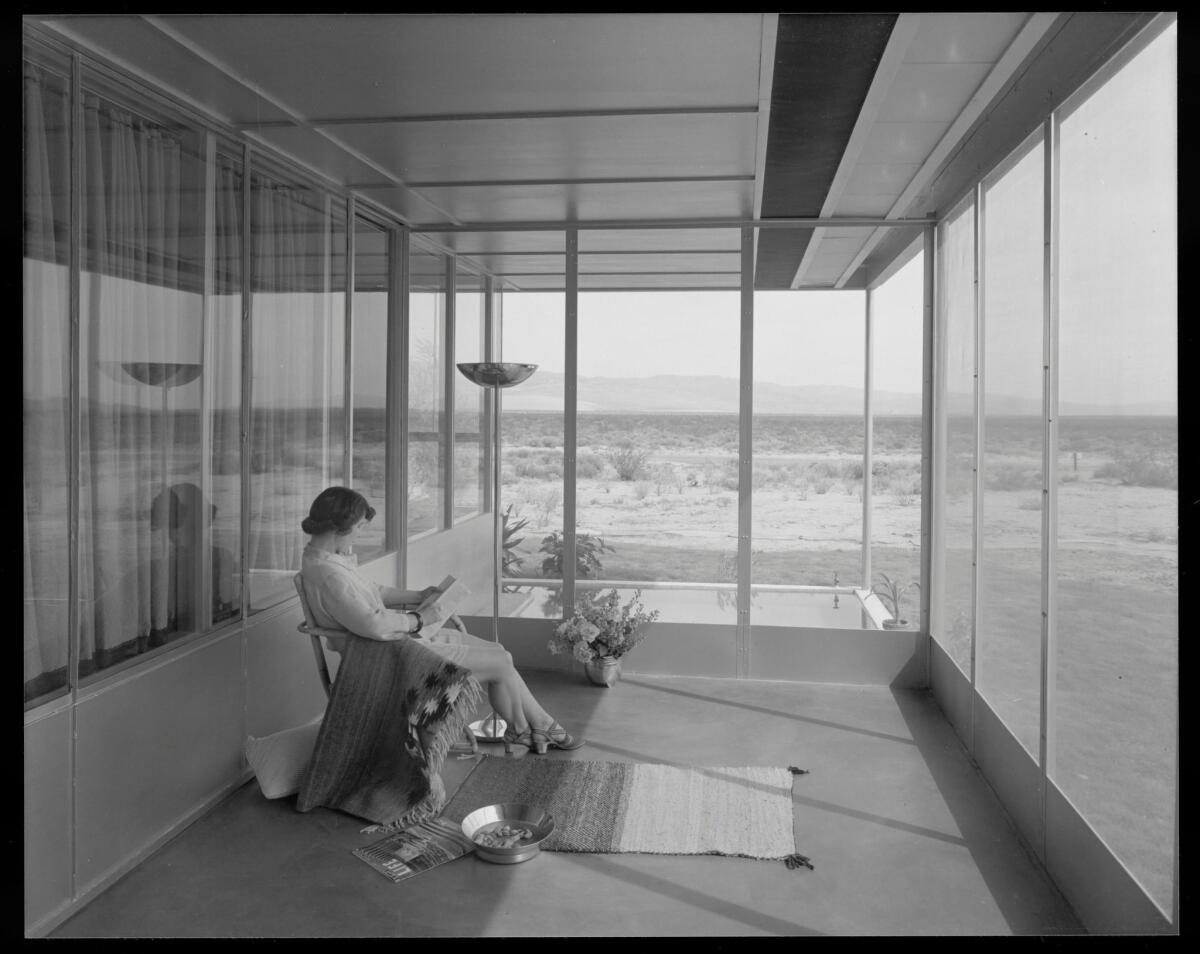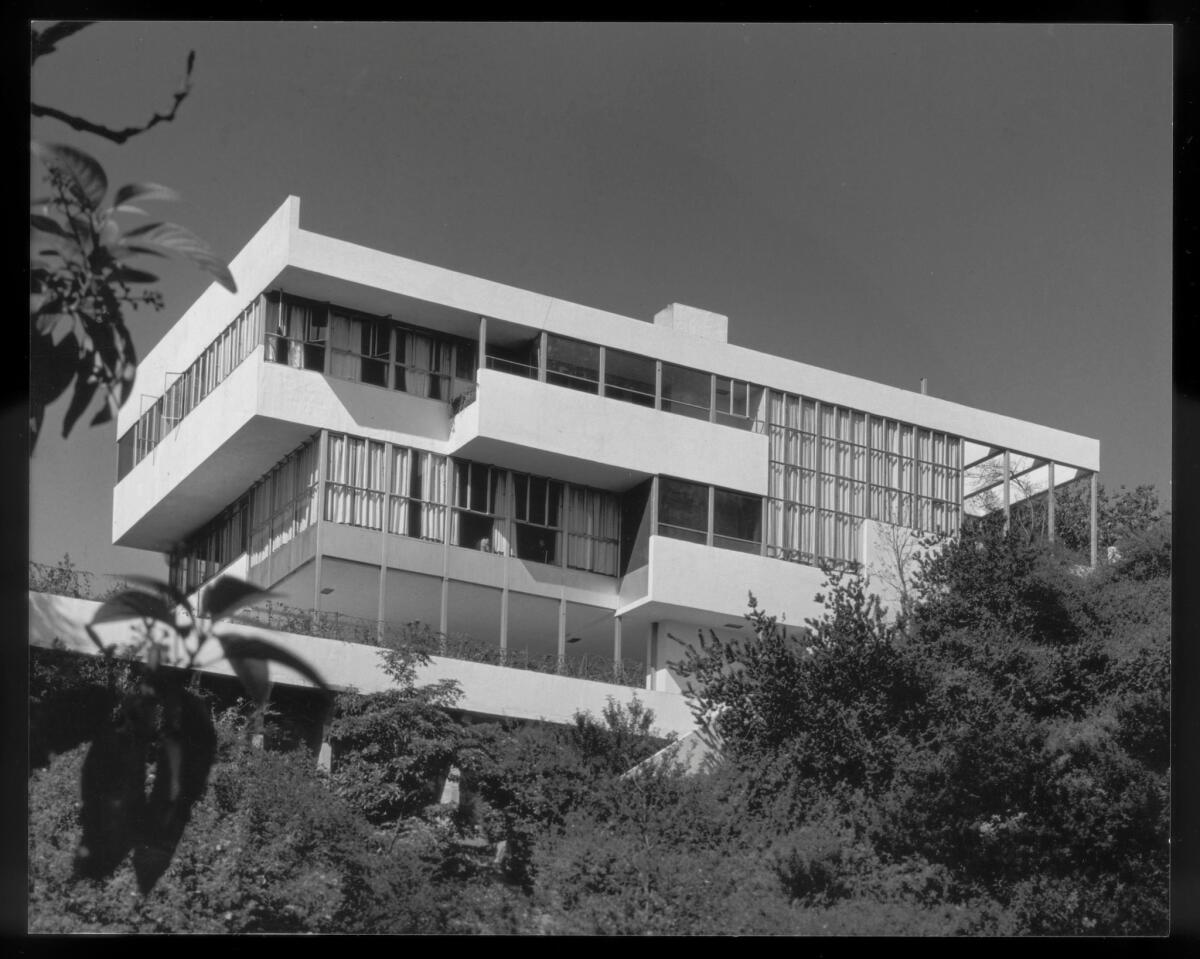How California became a health haven for proto-hippies, ‘Sun Seekers’ and modernists
- Share via
It’s easy to draw a line from today’s artisanal, organic avocado toast straight back to the sprouts, homemade yogurt, and rough, multigrain bread of the 1970s. In “Sun Seekers: The Cure of California,” Lyra Kilston complicates this history of health in the Golden State with stories that meander even further back to the mid-19th century. Her slim, eclectic volume relates how California was a beacon for all manner of health-conscious reformers, iconoclasts, and quacks, long before the days of the hippies. It’s an engaging, copiously illustrated read, creatively toeing the line between history and art book.
It all began with tuberculosis.
The mountains, the desert. Southern California had both… The sky was cloudless, nights cool, days brilliant, nature abundant.
— Lyra Kilston
“Sun Seekers” spends a good deal of time exploring the development of 19th century European sanatoriums designed to treat the disease. “Tuberculosis was the leading cause of death in Europe and the United States,” according to the book, “where an estimated 70 to 90 percent of the urban population was infected.” A New York City state legislative committee described the squalid environment of the tenements in the 1850s: “The dim, undrained courts oozing with pollution; the dark, narrow stairways, decayed with age, reeking with filth, over-run with vermin; the rotted floors, ceilings begrimed, and often too low to permit you to stand upright...”
Sited in remote locales with plenty of windows and balconies, the hybrid hospital-hotels replaced the cramped, dark, quarters of industrial cities with access to fresh air and sunshine.
“The antidote to this threatening urban existence, rife with contagion and disease beckoned,” Kilston writes. “The mountains, the desert. Southern California had both… The sky was cloudless, nights cool, days brilliant, nature abundant.” An 1870 official — obviously biased — state health report dubbed California the “Sanatorium of the World.”

California’s dry, mild climate and undeveloped wilderness were a logical, if far-flung frontier for radical practitioners and patients desperate for a cure. Kilston notes of the inventive and somewhat odd attempts by health seekers to experiment with nomadic living, sometimes in the wild. Some lived in tent cities, others lived outdoors on a carpet under a tree. Then there was the ailing Massachusetts man who “wandered the bucolic Ojai Valley with a cow, subsisting only on its raw milk until he claimed a miraculous recovery.”

After citing these adherents to al fresco living, Kilston then skillfully interweaves the histories of healthcare and modern architecture. “The hygienic focus of sanatoriums influenced the architecture of many building types,” she writes. One section, “The Architects and the Naturopath,” shuttles between the stories of European émigré architects R. M. Schindler and Richard Neutra and that of Dr. Philip Lovell, a self-described “doctor of naturopathy.” Born Morris Saperstein, Lovell traveled west from New York in the early 1920s, becoming a high-profile proponent of vegetarianism and nude sunbathing via a column in the L.A. Times.
His holistic approach extended to home design, and he commissioned Schindler and Neutra to create several houses that reflected his belief in the benefits of indoor-outdoor living. The culmination of this effort was Neutra’s Health House (now known as Lovell House), finished in 1929. It was an elegant stack of mostly translucent boxes studded with outdoor sleeping porches and overlooking a non-chlorinated swimming pool, gardens, and fruit trees in the Hollywood Hills. It was an extension of Neutra’s architectural philosophies, which he often shared in essays:
“The lasting, formative influence of the environment on our physiological and psychological health is no less urgent a concern than the debilitating, even lethal contaminants that have been set loose in the life cycles and food chains of the natural world ... Such fatigue-prone, nerve-wracking surroundings, seething with stressful impulses and fraught with neurasthenic friction, can literally make us sick.”
The house became famous in its own right. “Over several weekends in December 1929, thousands of curious Los Angeles residents traversed the winding, chaparral-fringed roads near Griffith Park to tour [Lovell’s] new house,” Kilston writes. Unlike the Spanish-style haciendas, the Italianate villas, or faux Tudor mansions that populated this neighborhood of film stars, crowds were there to see this paragon of modernism. Through his column at The Times, Lovell had personally invited the public to see how the house also reflected Lovell’s own theories of health, which he espoused in the paper: “For years I have periodically written articles telling you how to build your home so that you can derive from it the maximum degree of heath and beauty service… Always at the end of each article was the thought ‘If I ever build a home myself’ — At last that day has arrived.”
The Lovell house is now a touchstone of modern architecture, although its genesis as a “health machine” is often underplayed.
Kilston also highlights how the realms of naturopathic and hydropathic medicine offered rare opportunities for women in the mid-1800s. “Women were accepted as doctors and healers long before medical schools admitted them.” Advocates for “nature-cure” also promoted looser clothing for women instead of the restrictive apparel common at the time. In 1905, Dr. Bess Mensendieck, an American-born physician based in Vienna — and opponent of the corset — created an exercise regimen of “natural” movements for women. She also founded girls’ movement schools across Central and Northern Europe. And Dr. John Harvey Kellogg’s Battle Creek Sanitarium in Michigan, he “vehemently rejected the notion that women were inherently weaker … and prescribed them the same regimen[s] … that the men received.”
Efforts to optimize healthful living also had a darker side. Kilston examines “Lebensreform” in late 1800s Germany, a progressive, back-to-nature movement that emphasized cultivation of the body through organized outdoor activities. Its tenets were eventually co-opted by the Hitler Youth. “The tradition of organized hiking and folk nostalgia morphed into military camps and marching,” Kilston writes. Even exported to California, such ideas were tinged with eugenics. In conjunction with fears around immigration, the movement’s emphasis on perfecting the (always white) body was a driving force behind anti-miscegenation laws and the forced sterilization of nonwhite women in early 20th century California. “In California the superior climate and agriculture aroused not only wild claims about optimum health,” Kilston writes, “but also declarations about its potential to advance the human body, and thus, the species. One of the most chilling images in the book depicts a crowd viewing the exhibit, “Eugenics in New Germany” at the 1934 American Public Health Assn. meeting in Pasadena.
More sanguine are the stories of people Kilston dubs “hermits in the canyons,” lone men who came to California to live off the land. William Pester arrived from Germany sometime around 1906 and took up residence in a canyon near Palm Springs. He built a small hut, foraged for his food, and was known to strum a slide guitar. However, true isolation escaped him. By 1916, Pester had become a tourist attraction, selling postcard portraits of himself and promoting his austere lifestyle to visitors.
Similarly, eden ahbez, born George Alexander Aberle in Brooklyn in 1908, (He wrote his name in lowercase because he believed only “God” and “Infinity” should be capitalized.) He was part of a circle of proto-hippies, the “Nature Boys,” who lived outdoors but gathered to make music at Vera and John Richter’s Eutropheon Live Food Cafeteria, an early raw-food restaurant in downtown L.A. “He traveled with a sleeping bag, the clothes on his back, and a fruit juicer, scribbling song lyrics along the way,” Kilston writes. “Sometimes ahbez slept in the Richters’ backyard among their fruit trees. He also camped in various canyons near the city and for a time made his home in the shadow of the Hollywood sign.” He composed the song “Nature Boy,” popularized by Nat King Cole in 1947. Although the hit made ahbez rich, he remained a steadfast ascetic.
Kilston’s book is full of such quirky stories, ranging from Russian writer Anton Chekhov’s dying glass of Champagne, to a meditation on the beard and its changing role in signifying masculinity. These short narratives are printed on smaller, yellow pages, interspersed throughout the main text. This unconventional design — more at home in an art catalog than a history tome — reflects the book’s intertwining of many disparate strands. Yellow “gilding” on the edges of all the pages also creates an appropriately sunny “glow.” Content and design conspire to create a fascinating picture, by turns charming and chilling, of other times that continue to echo through this place.
::
“Sun Seekers: The Cure of California”
Lyra Kilston
Atelier Editions, 192 pp., $29.95
Mizota is an art critic and archivist whose writing appears regularly in the Los Angeles Times.
More to Read
Sign up for our Book Club newsletter
Get the latest news, events and more from the Los Angeles Times Book Club, and help us get L.A. reading and talking.
You may occasionally receive promotional content from the Los Angeles Times.









